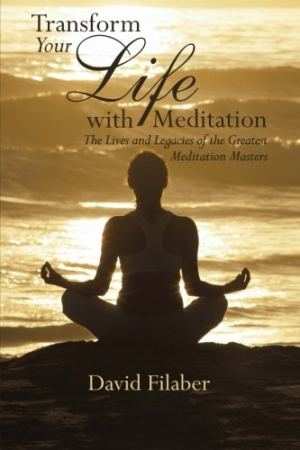
Transform Your Life with Meditation
The Lives and Legacies of the Greatest Meditation Masters
Biographies of eleven yogis offer diverse perspectives on meditation practice.
A resident of London, England, with a degree in psychology from Middlesex University, David Filaber began to explore meditation while attending the university. Visits to Thailand further piqued his interest in Buddhism and spiritual development. Filaber wrote Transform Your Life with Meditation to share his research on the value of a meditation practice.
Filaber gathered an extensive amount of general information on different types of meditation and on eleven different well-known spiritual teachers for the book. It concludes with a twenty-one page bibliography of YouTube videos that shares the Internet addresses of dozens of video clips of the eleven spiritual teachers. No other research is cited.
The first chapter attempts to explain what meditation is, and though it has a few rare moments of clarity, it is mostly ten pages of repetition. For example, the first two sentences of the chapter read, “Meditation is simply a way to spend ten to fifteen minutes a day doing absolutely nothing. Meditation is simply being able to remain present, in relation to the present moment, without thinking about anything, without thinking about the past or future.” These are typical examples of the majority of sentences in every chapter.
The variety of descriptive words is minimal. Several paragraphs, if not entire chapters, could be consolidated into a sentence or two. The same simple ideas, such as mindfulness, being consciously aware, and overcoming mental barriers, are reiterated over and over, with only the words being almost endlessly rearranged. There are countless grammatically awkward attempts to restructure sentences in order to find a deeply meaningful way to share a concept.
The chronic sameness of sentence into page into chapter carries over into the introduction to the eleven spiritual teachers. For the most part they are all uncomfortably interchangable and paint profoundly milquetoast overviews of the teachings of fundamentally different teachers such as Eckhart Tolle, Ramana Maharshi, and OSHO. To the authors credit, he does touch on the central teachings of the eleven in their respective chapter, but these moments are mostly disjointed and almost always lost in an avalanche of too many words. For example, in the chapter on OSHO, the following statements are weakened due to typos and poor grammar: “He felt that the self-awareness and inner observation meditation provides allows one to recognise one’s true nature of the mind, the true self, and thus achieve inner peace. Ultimately, OSHO felt that meditation allows one to remain in a space free from anxiety or disorder caused by ‘thoughts’ occurring in the mind.”
Transform Your Life with Meditation could be a valuable and readable book after a thoughtful rewrite focusing on the elimination of redundancies, clearing up sentence structure, and tightening up research on the spiritual teachers cited.
Reviewed by
Patty Sutherland
Disclosure: This article is not an endorsement, but a review. The publisher of this book provided free copies of the book and paid a small fee to have their book reviewed by a professional reviewer. Foreword Reviews and Clarion Reviews make no guarantee that the publisher will receive a positive review. Foreword Magazine, Inc. is disclosing this in accordance with the Federal Trade Commission’s 16 CFR, Part 255.
